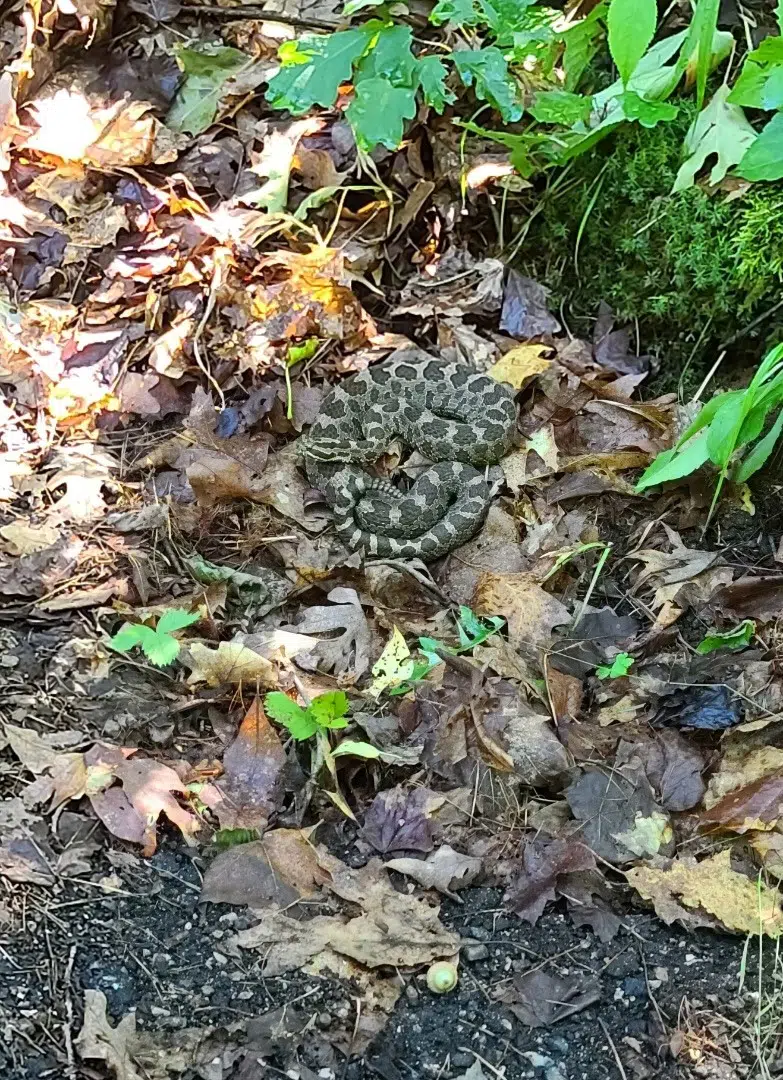A recent Massasauga Rattlesnake sighting in Kilworthy near the Severn River has prompted a local woman to remind people about the danger they can pose.
Kandis Johnstone and her partner Troy Sinister happened upon the snake with their dog this past Friday at about 10:30 am near the family cottage on Riverside Trail.
Their dog, a six-pound chihuahua called Pira, was sniffing a rockface within six inches of it when Troy heard the rattle.
Kandis wants people to know the snakes are in the area and to be vigilant when trekking around in the woods.
“I hope people keep their eyes on the ground while walking in nature,” she says. “You never know what you’ll find.”

The Massasauga usually occurs primarily along the eastern side of Georgian Bay and on the Bruce Peninsula. It is listed as Threatened on the Species at Risk in Ontario (SARO) List.
These species are protected from being harmed, harassed or killed, and their habitat is protected from damage and destruction. Under the Act, it is also illegal to collect these species from the wild, or to buy, trade or sell them.
The Massasauga is also listed as a Specially Protected Reptile under the Fish and Wildlife Conservation Act, 1997, which provides additional protection for individuals of this species.
The Massasauga is Ontario’s only venomous snake species. Massasaugas are described as shy, docile snakes that avoid confrontation with humans whenever possible, often relying on their excellent camouflage and cryptic behaviour to remain unseen.
If a Massasauga is encountered, give it space and appreciate it from a safe distance (e.g., a few metres).
Massasauga bites in Ontario can occur if people take unnecessary risks (e.g., walking through habitat in bare feet) or intentionally attempt to harass or capture a snake.
By taking a few simple precautions, you can ensure that an encounter with a Massasauga is a positive one: when in Massasauga habitat, always wear closed-toed shoes, pay careful attention to where you are walking and placing your hands, pay attention for and heed the rattle sound, and never attempt to capture or harm a Massasauga (as this is also prohibited by law).
Although Massasaugas are venomous, there are only two historical records of human fatalities resulting from Massasauga bites in Ontario, and both occurred more than 60 years ago. Given the small size of Massasaugas (and thus low venom yield), as well as the current knowledge of snakebite prevention and treatment in Ontario, Massasaugas present a relatively low risk to public safety.
“However, when bites do occur, they are a serious, potentially life-threatening situation and should be treated as such,” relays Lindsay Davidson with Communications at Ontario’s Ministry of the Environment, Conservation and Parks. “If someone is bitten by a Massasauga, ensure the individual remains calm and as inactive as possible, call 911, remove any jewellery or restrictive clothing from the area around the bite, and immediately proceed to a hospital.”
The Massasauga primarily occurs along eastern Georgian Bay, but populations do extend east into the western portion of the Muskoka area, including the area around Gravenhurst and Kilworthy.
However, the species is less common in this area and sightings are not as frequent as in areas closer to the eastern Georgian Bay coastline.
“We are not aware of any increases in the incidence of observations of this species from the Muskoka area,” says Davidson “An up-to-date range map that reflects the best available information on the species’ occurrence in Ontario is available on the Ontario Reptile and Amphibian Atlas website”
Individuals who encounter species at risk (SAR), including Massasaugas, are encouraged to submit their sightings to the Natural Heritage Information Centre (NHIC), which is Ontario’s conservation data centre.
Joining the (NHIC) Rare Species of Ontario project in iNaturalist makes submitting observations quick and easy. The Ministry of the Environment, Conservation and Parks rely on the public to submit occurrences of SAR to help track and monitor the distribution and status of these species across the province. The submission of sightings is especially important in areas where the species is less common and may not have been previously documented.
An increase in reports or sightings of this species from one year to another may occur due to a number of reasons, such as people spending more time in nature, and is not necessarily an indication of any change in abundance of the local Massasauga population.
Based on the most recent Committee on the Status of Endangered Wildlife in Canada (COSEWIC) Assessment and Status Report on the Massasauga in Canada, this species is believed to be in decline across much of its range, particularly in areas with high human population densities and road networks.
Locally, Muskoka Algonquin Healthcare (MAHC) tells Country 102 that anti-venom to treat Massasauga rattlesnake bites in Muskoka is available at the South Muskoka Memorial Hospital Site in Bracebridge.
If a pet is bitten, the O’Sullivan Animal Hospital in Barrie carries anti-venom for pet bites.
The West Parry Sound Health Centre is the Ontario depot that manages the anti-venom supply for the province.
(Photo via Kandis Johnstone)



